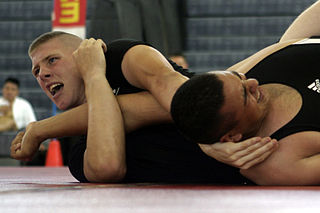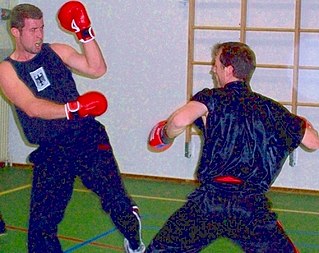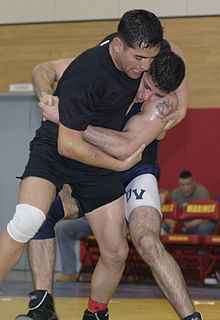
Grappling, in hand-to-hand combat, is a sport that consists of gripping or seizing the opponent. Similarly to wrestling, grappling is used at close range to gain a physical advantage over an opponent such as imposing a position, or to cause injury to the opponent. Grappling covers techniques used in many disciplines, styles and martial arts that are practiced both as combat sports and for self-defense. Grappling contests often involve takedowns and ground control, and may end when a contestant concedes defeat, also known as a submission or tap out.

Kickboxing is a group of stand-up combat sports based on kicking and punching, historically developed from karate mixed with boxing. Kickboxing is practiced for self-defence, general fitness, or as a contact sport.

A kick is a physical strike using the leg, in unison usually with an area of the knee or lower using the foot, heel, tibia (shin), ball of the foot, blade of the foot, toes or knee. This type of attack is used frequently by hooved animals as well as humans in the context of stand-up fighting. Kicks play a significant role in many forms of martial arts, such as savate, taekwondo, MMA, sikaran, karate, Pankration, Kung Fu, Vovinam, kickboxing, Muay Thai, Yaw-Yan, capoeira, silatand kalaripayattu. If the kick is to a target, it is a form of compliance
Martial arts are codified systems and traditions of combat practiced for a number of reasons such as self-defense; military and law enforcement applications; competition; physical, mental and spiritual development; and entertainment or the preservation of a nation's intangible cultural heritage.

Muay Thai or literally Thai boxing is a combat sport of Thailand that uses stand-up striking along with various clinching techniques. This discipline is known as the "art of eight limbs" as it is characterized by the combined use of fists, elbows, knees, and shins. Muay Thai became widespread internationally in the late 20th to 21st century, when westernized practitioners from Thailand began competing in kickboxing, mixed rules matches, as well as matches under Muay Thai rules around the world. The professional league is governed by The Professional Boxing Association of Thailand (P.A.T) sanctioned by The Sports Authority of Thailand (SAT), and World Professional Muaythai Federation (WMF) overseas.

Filipino martial arts (FMA) refer to ancient Indianized and newer fighting methods devised in the Philippines. It incorporates elements from both Western and Eastern Martial Arts, the most popular forms of which are known as Arnis, Eskrima, and Kali. The intrinsic need for self-preservation was the genesis of these systems. Throughout the ages, invaders and evolving local conflict imposed new dynamics for combat in the islands now making up the Philippines. The Filipino people developed battle skills as a direct result of an appreciation of their ever-changing circumstances. They learned often out of necessity how to prioritize, allocate and use common resources in combative situations. Filipinos have been heavily influenced by a phenomenon of cultural and linguistic mixture. Some of the specific mechanisms responsible for cultural and martial change extended from phenomena such as war, political and social systems, technology, trade and practicality.

Japanese martial arts refer to the variety of martial arts native to the country of Japan. At least three Japanese terms are used interchangeably with the English phrase Japanese martial arts.

A strike is a directed physical attack with either a part of the human body or with an inanimate object intended to cause blunt trauma or penetrating trauma upon an opponent.
The following outline is provided as an overview of and topical guide to martial arts:

Submission wrestling or combat wrestling, is a form of competition and a general term for martial arts and combat sports that focus on clinch and ground fighting with the aim of obtaining a submission through the use of submission holds. The term "submission wrestling" usually refers only to the form of competition and training that does not use a gi, or "combat kimono", of the sort often worn with belts that establish rank by color, though some may use the loose trousers of such a uniform, without the jacket. Not using a gi has a major impact on the sport : there are many choke techniques which make use of the lapels of the gi, thus rendering them un-useable and grappling in general becomes more difficult when the opponent doesn't have a gi to grab hold of.

SANDA / , also known as Chinese boxing or Chinese kickboxing, is the official Chinese full contact combat sport. Sanda is a fighting system which was originally developed by the Chinese military based upon the study and practices of traditional Kung fu and modern combat fighting techniques; it combines full-contact kickboxing, which includes close range and rapid successive punches and kicks, with wrestling, takedowns, throws, sweeps, kick catches, and in some competitions, even elbow and knee strikes.

Stick-fighting, stickfighting, or stick fighting is a variety of martial arts which use simple long slender, blunt, hand-held, generally wooden "sticks" for fighting; such as a staff, cane, walking stick, baton or similar. Some techniques can also be used with a sturdy umbrella or even a sword in its scabbard.

The front kick in martial arts is a kick executed by lifting the knee straight forward, while keeping the foot and shin either hanging freely or pulled to the hip, and then straightening the leg in front of the practitioner and striking the target area. It is desirable to retract the leg immediately after delivering the kick, to avoid the opponent trying to grapple the leg and to return to stable fighting stance.

Ground fighting is hand-to-hand combat or wrestling, which takes place while the combatants are on the ground. The term is commonly used in mixed martial arts and other combat sports, as well as various forms of martial arts to designate the set of grappling techniques employed by a combatant that is on the ground. It is the main focus of Brazilian Jiu-Jitsu and is featured in varying amounts in Catch wrestling, Judo, Sambo, Shoot wrestling, Dishuquan Dog Kung Fu, some schools of Shuai Jiao and other styles of wrestling.

In martial arts and combat sports, stand-up fighting is hand-to-hand combat between opponents in a standing position, as distinguished from ground fighting. Clinch fighting is stand-up grappling. Fighters employ striking, including striking combinations, using either body parts or mêlée weapons, to incapacitate or injure the opponent. Combatants use blocking techniques to block the opponent's attacks.

Clinch fighting is the part of stand-up fighting where the combatants are grappling in a clinch, typically using clinch holds. Clinching the opponent can be used to eliminate the opponent's effective usage of some kicks, punches, and melee weapons. The clinch can also be used as a medium to switch from stand-up fighting to ground fighting by using takedowns, throws or sweeps.

Footwork is a martial arts and combat sports term for the general usage of the legs and feet in stand-up fighting. Footwork involves keeping balance, closing or furthering the distance, controlling spatial positioning, and/or creating additional momentum for strikes.

The World Association of Kickboxing Organizations is an international organization of kickboxing. The governing body of amateur kickboxing certified by WAKO is created to develop support and govern at an amateur level In addition to holding world championship events, WAKO sanctions the champions of kickboxing. WAKO is the only organisation worldwide that is recognised by the GAISF and the IOC.

Jujutsu, also known as jujitsu or jiu-jitsu, is a Japanese martial art and a method of close combat for defeating an opponent in which one uses either a short weapon or none.

Combat is a purposeful violent conflict meant to weaken, establish dominance over, or kill the opposition, or to drive the opposition away from a location where it is not wanted or needed.